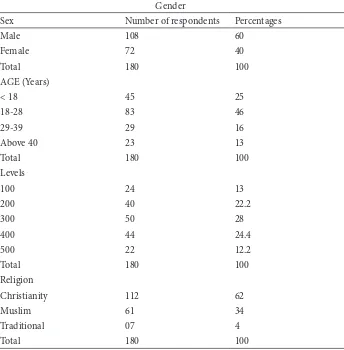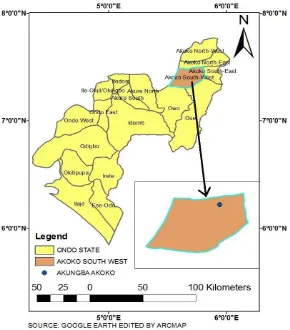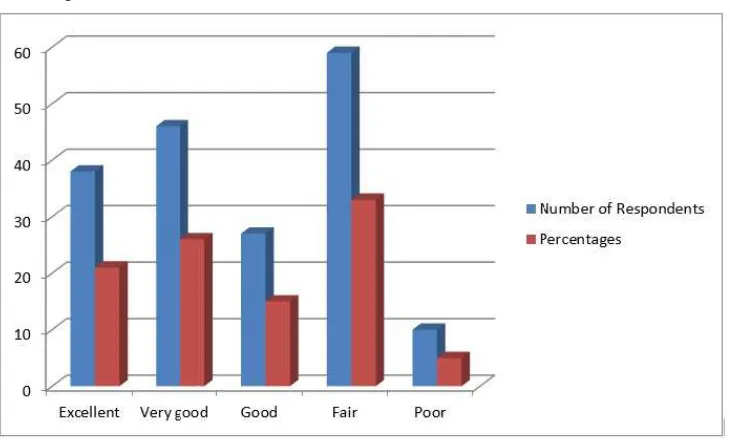Indonesian Journal of Geography Vol. 49, No.1, June 2017 (11 - 16) DOI: http://dx.doi.org/10.22146/ijg.12437, website: https://jurnal.ugm.ac.id/ijg © 2017 Faculty of Geography UGM and he Indonesian Geographers Association
Infrastructural Facility and the Students’ Academic Performance - A Critique
Adejompo Fagbohunka
Received:16 07 2016 / Accepted: 14 10 2016 / Published online: 31 06 2017 © 2017 Faculty of Geography UGM and he Indonesian Geographers Association
Abstract he paper underscores the infrastructural facility and the student’s academic performance in Adekunle Aja-sin University, Akungba Akoko, Ondo State, Nigeria. hirty questionnaires were administered through a systematic sampling technique in each of the six faculties making a total of 180 questionnaires. he paper has found out a positive relationship between the student’s academic performance, power supply and health facilities. However, the internet fa-cilities and transportation fafa-cilities were not adequate, whereas water supply was adequate. A test of the impact of infra-structural facility on the student’s academic performance, using a Chi Square statistical technique revealed a signiicant value of 177.1 at 0.05 % level. he paper recommends that the existing facilities should be upgraded and signiicantly improved by the government; urgent attention should be given to the development of the internet facilities and trans-portation sector of the University. Also, private partnership should be encouraged in the infrastructural development of the University.
Abstrak Makalah ini membahas mendasar tentang fasilitas infrastruktur dan prestasi akademik siswa di Universitas Adekunle Ajasin, Akungba Akoko, Ondo State, Nigeria. Tiga puluh kuesioner diberikan melalui teknik sampling sistematis di masing-masing dari enam fakultas yang menghasilkan total 180 kuesioner. Makalah ini telah menemukan hubungan positif antara kinerja akademik siswa, fasilitas catu daya dan kesehatan. Namun, fasilitas internet dan sarana transpor-tasi tidak memadai, padahal pasokan air sudah memadai. Uji dampak fasilitas infrastruktur terhadap prestranspor-tasi akademik siswa, dengan teknik statistik Chi Square menunjukkan nilai signiikan 177,1 pada tingkat 0,05%. Makalah ini mere-komendasikan agar fasilitas yang ada harus ditingkatkan dan ditingkatkan secara signiikan oleh pemerintah; Perhatian mendesak harus diberikan pada pengembangan fasilitas internet dan sektor transportasi Universitas. Selain itu, kemitraan swasta harus didorong dalam pengembangan infrastruktur Universitas.
Keywords: Academic performance, Infrastructural facility, Students, University
Kata kunci: Mahasiswa, Kinerja Akademik, Sarana Infrastruktur, Universitas
1.Introduction
Infrastructure plays a very important role in the growth process of an economy; thereby raising the level of productivity and also leads to a higher potential level of output for the future Infrastructure refers to the fundamental facilities and systems serving a country, city, or area, including the services and facilities necessary for its economy to function. Infrastructural development involves fundamental structures that are required for the functioning of a community and society. his is usually referred to as structures like roads, water supply, sewers, electrical grids, telecommunications, renewable energy, and so on [Abosedra etal, 2009; Mandel, 2008; Frischmann, 2007; CBN, 2003; Pendse, 1980].
here is actually a general belief that the condition of school’s learning environment, especially infrastructure has an important impact on students’academic performance and efectiveness. he facilities that are needed to facilitate efective learning in an educational institution include adequate power and water supply,
good communication system, improved transportation system, adequate classrooms, libraries, laboratories as well as furniture items and sporting equipment. he quality of infrastructure has strong inluence on the academic standard which is an index of quality assurance in the school. For instance, Earthman [2002], reporting on California, revealed that comfortable classroom temperature and smaller classes enhance students efectiveness and provide opportunities for participation more fully in discussions, reduce discipline problems and thereby enhanced better performance than students in schools with substandard buildings by several percentage points.
Sustainable economic growth oten occurs in an environment where there is a meaningful infrastructural development, and there is evidence that it reduces inequality in the society. It is also clear that development of infrastructure (energy, transport, water, ICT among others) generally contributes signiicantly to the level and quality of development of an area. University wield tremendous importance to the socio-economic transformation of any region, because knowledge is power, knowledge liberate from ignorance and poverty to all round social economic development. Some impacts expected of a university region are numerous; ranging from employment Adejompo Fagbohunka
Geography and Planning Sciences Department, PMB 001, Adekunle Ajasin University, Akungba Akoko, Ondo State, Nigeria.
creation, increase housing units to improve adequate infrastructure facilities. Adequate infrastructural facility is therefore a pre-requisite for running these Universities and also for the student to be able to hit the ground running academically. An underdeveloped region can be developed through the establishment of a University, thereby posing a great value to the overall development of such area.
he contribution of infrastructural facility to economic development is enormous, since it provides the environment for productive activities to take place, encourage investment, allows wider movement of goods and people facilitates information lows and helps commercialize and diversify the economy [World Bank, 1994]. he quest for adequate infrastructure in Nigeria tertiary education sector cannot be abandoned because it is the bedrock of development and highly needed for successful, standard and quality education. Infrastructure development can reduce stress and promote good health. It will also reduce crime level. Infrastructure has always played a key role in integrating economies within a region. Well developed and eicient infrastructure is essential for a region’s economic development and growth. In a dynamic concept, infrastructure is seen as a regional public good that moves factors of production within and across countries, thus helping the region attain higher productivity and growth.
Infastructure can have a strong impact on the incidence and depth of poverty by supporting inclusive growth, i.e., economic growth that can facilitate a meaningful and sustainable poverty reduction [World Bank, 2009]. Research on infrastructure dwells on diferent issues such as education, roads, water supply, power grids, telecommunication and hospitals [Abosedra et al. 2009; Mandel, 2008; Frischmann, 2007; CBN 2003; Pendse, 1980]. According to Kathmandu Final Workshop Report [2009], infrastructure can help solve four problems: social; health and environment; development; and, economics. Abosedra etal [2009] stated that infrastructure development involves fundamental structures that are required for the functioning of a community and society.
he importance of infrastructural services to economic development is enormous. As observed by Fox [1994], Jimenez [1994], World Bank [1994], Lanjouw [1995], and ADB [2009] infrastructure provides the conducive environment for productive activities to take place and facilitate the generation of economic growth. For instance, in the absence of adequate power supply, water, transportation and communication facilities, production process or location advantages may not be optimized. On the other hand, availability of an eicient infrastructure network can stimulate new innovation in the other sectors.
2.he Methods
Akungba-Akoko is situated in Akoko southwest
local government area of Ondo-state in south western part of Nigeria. It is the community in which Adekunle Ajasin University is located. It’s geographical coordinates are latitude 7°24 ‘0 and 7°28 ‘0 ’North, and longitude 5°44 ‘0’ and 5°45 ‘0’ East. he town is surrounded by little hills and bounded by some towns such as Ikare in the North, Oka in the East, Etioro in the South, and Supare in the West.
Adekunle Ajasin University, Akungba-Akoko was established in March 1982 by the government of the old Ondo State, headed by the late Chief Adekunle Ajasin. At present, Adekunle Ajasin University Akungba-Akoko (AAUA) has a well over 10,000 students, and over 1,200 staf – academic and non-academic - and six Faculties – Arts, Education, Law, Science, Social and Management Sciences and Agriculture.
Data was collected through a systematic random sampling technique. First, ive departments in each of the six faculties were randomly sampled, while six questionnaire was administered in each of these department. On the whole thirty questionnaires were administered in each of the six faculties, making a total of one hundred and eighty. Secondary data were also employed and the data analyzed descriptively and inferentially.
Table 1 shows the socio-economic characteristics of the respondents, 108(60%) were males, while 72(40%) were females. Also, 83(46%) were between 18 and 28 years, whereas 23(13%) were above 40 years. Furthermore, 24 (13%) were in 100 level, while 50 (28%) were in 300 level; another 22(12.2%) were in 500 level. One hundred and twelve respondents are Christian, whereas 7(04%) were involved in traditional religion.
Table 2 depicts the inluence of power supply on the student’s academic performance, 79 (44%) respondents opined very satisfactory, whereas 36 (20%) opined not satisfactory; another, 19 (10%) agreed averagely satisfactory. It is therefore, apparent that power supply has a positive inluence on the student’s academic performance.
Figure 1 reveals the efects of internet facilities on the student’s academic performance, (12 6.6%) believed that the internet facilities has very signiicant efect, whereas 126(70%) were of the opinion that it the internet facilities has contributed insigniicantly to the students performance academically.
Table 3 reveals that 141 (78%) respondents agreed that water supply has a very adequate contribution to the student’s academic performance, whereas only 1(1%) opined grossly inadequate.
Table 1. Socio-Economic Variables of the Respondents Gender
Sex Number of respondents Percentages
Male 108 60
Female 72 40
Total 180 100
AGE (Years)
< 18 45 25
18-28 83 46
29-39 29 16
Above 40 23 13
Total 180 100
Levels
100 24 13
200 40 22.2
300 50 28
400 44 24.4
500 22 12.2
Total 180 100
Religion
Christianity 112 62
Muslim 61 34
Traditional 07 4
Total 180 100
Table 2. Inluence of Power supply on Students Academic Performance
Efects Number of
Respondents
Percentages
Very satisfactory 79 44
Satisfactory 46 26
Averagely Satisfactory 19 10
Not satisfactory 36 20
Total 180 100
Field Survey, 2015
Table 3. Water Supply and the Students Academic Performance
Efects Number of
Re-spondents
Percent-ages
Very Adequate 141 78
Adequate 25 14
Inadequate 13 07
Grossly Inadequate 1 1
Nil
-Total 180 100
Field Survey, 2015.
Table 4. Students Academic Performance and the Transportation System
Efects Number of Respondents Percentages
Positive 23 13
Negative 126 70
Nil 31 17
Total 180 100
Field Survey, 2015.
Table 4 shows that 126 (70%) respondents asserted that there has been a negative relationship between the student’s academic performance and the transportation system, while 23(13%) believed that positive relationship exists between the student’s academic performance and the transportation system
Table 5. Adequacy of Infrastructural Facilities in Adekunle Ajasin University
Adequacy Number of Respondents Percentages
Adequate 78 43.3
Inadequate 96 53.3
Nil 06 03.3
Total 180 100
Field Survey, 2015.
Figure 2. he Impacts of Health Facilities on Students Academic Performance Source: Ministry of Lands and Housing, Akure, 2013
Table 5 shows the adequacy of infrastructural facilities in Adekunle Ajasin University, out of 180(100%) respondents, 96(53.3%) opined inadequate, whereas 78(43.3%) agreed that infrastructural facilities is inadequate.
Figure 3 shows that 38(21%) respondents opined an excellent academic performance of students as a result of infrastructural facilities, whereas 59(33%) believed that infrastructural facilities have a fair efects on students performance. Another, 10(5%) agreed that infrastructure has impacted poorly on the student’s academic performance.
Table 6. Chi- Square Test on the Efect of Infrastructural Facilities on Students Academic
Performance
Option O E O –E (O-E)2 (O-E)2
E
Excellent 38 90 52 2704 30
Very good 46 90 44 1936 21.5
Good 27 90 63 3969 44.1
Fair 59 90 31 961 10.7
Poor 10 90 80 6400 71.1
177.4
he Chi-Square test carried out in table 6 on the efects of infrastructural facilities on the student’s academic performance has revealed Calculated Chi-Square value 177.1 and tabulated Chi-Chi-Square value 15.815. his further lends credence to the fact that infrastructural facilities have a positive relationship to the academic performance of students in Adekunle Ajasin University, Akungba Akoko.
4.Conclusion
he paper has examined the inluence of infrastructural facilities on the student’s academic performance of Adekunle Ajasin University Akungba Akoko. Universities play a crucial role in society as producers and transmitters of knowledge, teaching and research which is the most important function of university leads to development in diverse ways. It must be noted that the teaching and research could be efectively enhanced under conducive atmosphere of adequate infrastructural facilities. he paper has revealed a signiicant positive relationship between power supply and the student’s academic performance. he research further revealed that the following infrastructural facilities such as, water supply and the health facilities have contributed tremendously to student’s performance.
he paper shows that infrastructural facilities like, the internet facilities and transportation has insigniicant contribution to the student’s academic performance. Despite the fact that research reveals inadequacy of infrastructural facilities, the chi-square test carried out on the efects of infrastructural facilities on the student’s academic performance at 0.05 signiicant levels reveals a calculated chi square value of 177.1 compared to the tabulated chi-square value of 15.82. his connotes that infrastructural facilities has positively afected the student’s academic performance.
Despite the role of University in knowledge transfer activities and its contribution to economic development, infrastructural facilities has been one of the major clog in the wheel of meaningful contribution of Universities to regional socio economic revamping. he paper has revealed that much is still needed to be done in two critical areas of transportation and the internet facilities, in this era of globalization adequate internet facilities is very germane, as it will enhance the
Figure. 3 Efects of Infrastructural Facilities on Students Academic Performance
students to favourably compete with their counterparts in any part of the world.
he student’s performance, contribution to socio economic development, ability to compete excellently in the technological world is hinged on infrastructural facility development. It is therefore, recommended that the government should be more concerned, involved and invested on the infrastructural facilities in the University. he University management should try to secure a private partnership in infrastructural development and must in turn adequately maintained the existing infrastructural facilities, while the students also needs to be sensitized on the need to maintain the existing infrastructural facilities on campus.
References
Abosedra, S. (2009). Electricity Consumption and Economic Growth: the Case of Lebanon, in Applied Energy 86(4): 429-432.
Africa Development Bank (ADB) (2009). An Overview of the Infrastructure Strategy Including MTS. ADB, Abidjan, Ivory Coast.
Ayeni, A.J. et al. (2012). Improving learning infrastructure and environment for sustainable quality assurance practice in secondary schools in Ondo State, South-West, Nigeria. International Journal of Research Studies in Education, Volume 1 Number 1, 61-68.
Central Bank of Nigeria (CBN)(2003).Highway Maintenance in Nigeria: Lessons from other Countries’, Research Occasional Paper, 27.
Deepika, G. (2002). Impact of Infrastructure on Productivity: Case of Indian Registered Manufacturing. Centre for Development Economics; Working Paper No. 6.
Earthman, G. I. (2002). School facility conditions and student academic achievement. Los Angeles: University of California’s Institute for Democracy, Education and Access. (http://www.ucla-idea.org).
Frischmann, B.M. (2007). An Economic heory of Infrastructure and Commons Management in Minnesota Law Review, 89(917).
Fox W.F. (1994). Strategic Options for Urban Infrastructural Management, UNDP/UNCHS/.
World Bank Urban Management Progress, No. 6 Gafar, T. and Saad, B. (2009). An Empirical Analysis of the
Long-Run Efect of Infrastructure on Industrialization in Nigeria. Journal of International economic Review, 2:1- 2(2009):135-149.
Jimenez, F. (1994). Human and Physical Infrastructure: Public Investment and Pricing Policies in Developing Countries, World Bank Policy Research Working Paper No. 1281 Lanjouw, P. (1995), Infrastructure: A Ladder for the Poor:
IMF/ World Bank Finance and Development, 32(1), 33-35.
Mandel, G.W. (2008). When to open infrastructure access’, in Ecology Law Quarterly, 35(2): 205-214.
Pendse, D.R. (1980).Energy Crisis and its Impact on Energy Consumers in the hird World:Economic and Political Weekly, 15(4): 175-184.


